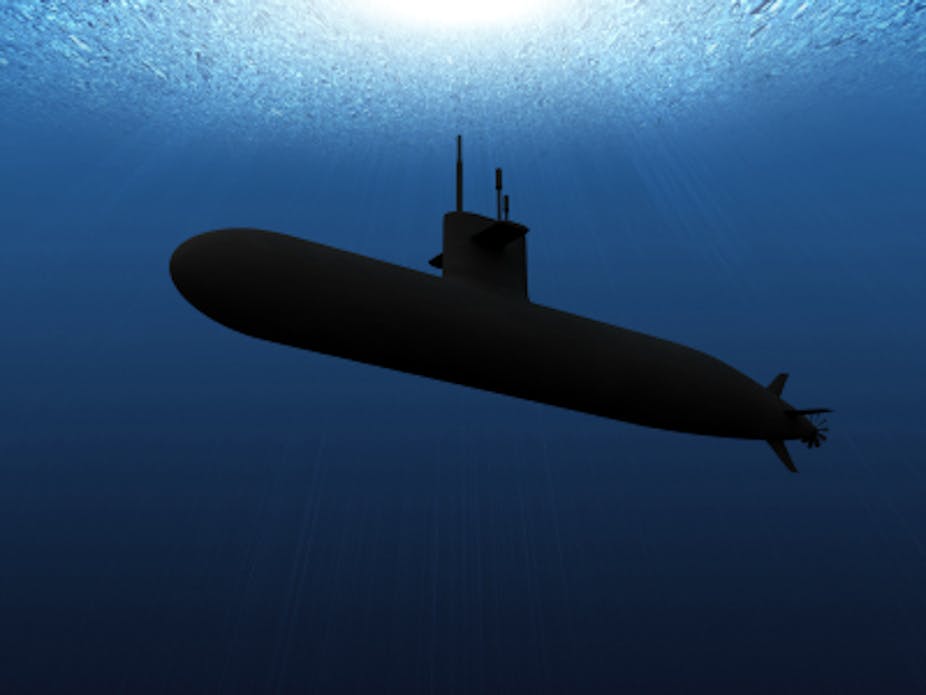In 2011 Minister for Defence Stephen Smith announced a review on the Sustainment of Australia’s Collins Class submarines.
The review is led by John Coles, an independent expert from BMT Defence Services in the UK. An interim report has just been released (while the final report is due by April 2012).
There have been a number stories published in the press (led by The Australian‘s Cameron Stewart) on the issues with the submarine fleet.
Australia’s Collins Class submarines are the most expensive in the world. The fleet of six submarines costs taxpayers $630 million a year to maintain, or $105 million for each submarine. In comparison, the US Navy Ohio – a nuclear submarine which holds three times more crew and is five times bigger costs about $50 million a year (see figure below).

The 2007-08 performance outcome for the Collins fleet shows that it achieved only 64% of its mission capability and, according to opposition Defence spokesman David Johnston, the fleet rarely features more than two operational submarines at the same time.
In June 2011, The Australian published a story claiming there was not a single Collins-class submarine that was seaworthy at the time while 40 serious defects were discovered on one of the submarines.
Understanding the need for a new and more efficient fleet, the 2009 Defence White Paper calls for 12 large submarines which could cost up to $35 billion and could be built in South Australia, according to the Defence Industries Minister. At first, off-the-shelf submarines were considered. However, the French-Spanish Scorpene class boat and the Spanish S-80 submarine have been ruled out as Defence argued that they did not meet requirements Australia’s broad needs.
Some defence experts do believe that the Collins-class submarines are a naval engineering triumph and a showcase of Australia’s expertise. According to Derek Woolner, an expert on defence procurement projects based at ANU, the Collins-class submarines represent one of the few military projects that was delivered close to budget and an average of 26 months behind schedule, one of the shortest delays with military purchases. It is also a unique concept with no other engineering design of its kind anywhere in the world.

But the technical issues surrounding the submarines are further strained by internal conflicts within Defence’s engineering workforce. In October 2011, the engineering union APESMA (Association of Professional Engineers, Scientists & Managers Australia) conducted a careers intentions survey at a key Defence workplace that underpins the maintenance of the current Collins class submarines and the expertise for the future submarine program.
The survey found that 80% of engineering staff plan to leave within five years if engineering issues (related to work and pay conditions) are not addressed soon. There is already deep concern that Australia’s existing engineering defence workforce lacks the expert technicians to deliver the fleet of 12 new submarines, and may need to partner with another nation to fill the gaps.
This view is shared by the review panel, as included in the interim report:
“In Canberra, it is difficult to find more than a couple of individuals with any serious claim to submarine domain knowledge; in SA and WA the participants are critically dependant on a few key experienced individuals. The impression we gained was of an organisation surviving from day to day, with no spare capacity to think about the future. Without a clear plan to resolve this situation, it will be just a matter of time before the program grinds to a halt or the risk of a serious incident reaches unacceptable levels.”
Why is it so hard to get it right?
In his excellent piece in The Conversation, Derek Woolner explains that acquiring military equipment is a complex process in itself. It’s a fine balance between understanding the complicated technical nature of the equipment, evaluating the risks involved, taking into account the large time frames and possible delay. The political games outside and within Defence don’t help either.
The Australian Strategic Policy Institute (ASPI) released a report last month about the risks involved when acquiring military equipment. It looks at three possible views to evaluate risks:
- the use of commercial investment analysis that could be used by the military
- the desperate need of qualified project managers to make the right decisions when evaluating and agreeing to take on more projects and the input that the private sector can provide.
The way forward
The interim review provided a much-needed glimpse into the way Defence operates when it comes to the Collins-class submarines.
It showed us that the situation is complex with many stakeholders at play. Defence has pledged to implement some of the recommendations immediately. The maintenance and design of the existing and new submarines is clearly an engineering project of gigantic size.
But as John Thornton so elegantly puts its: “If ever a project required a Team Australia approach, this is it.”

